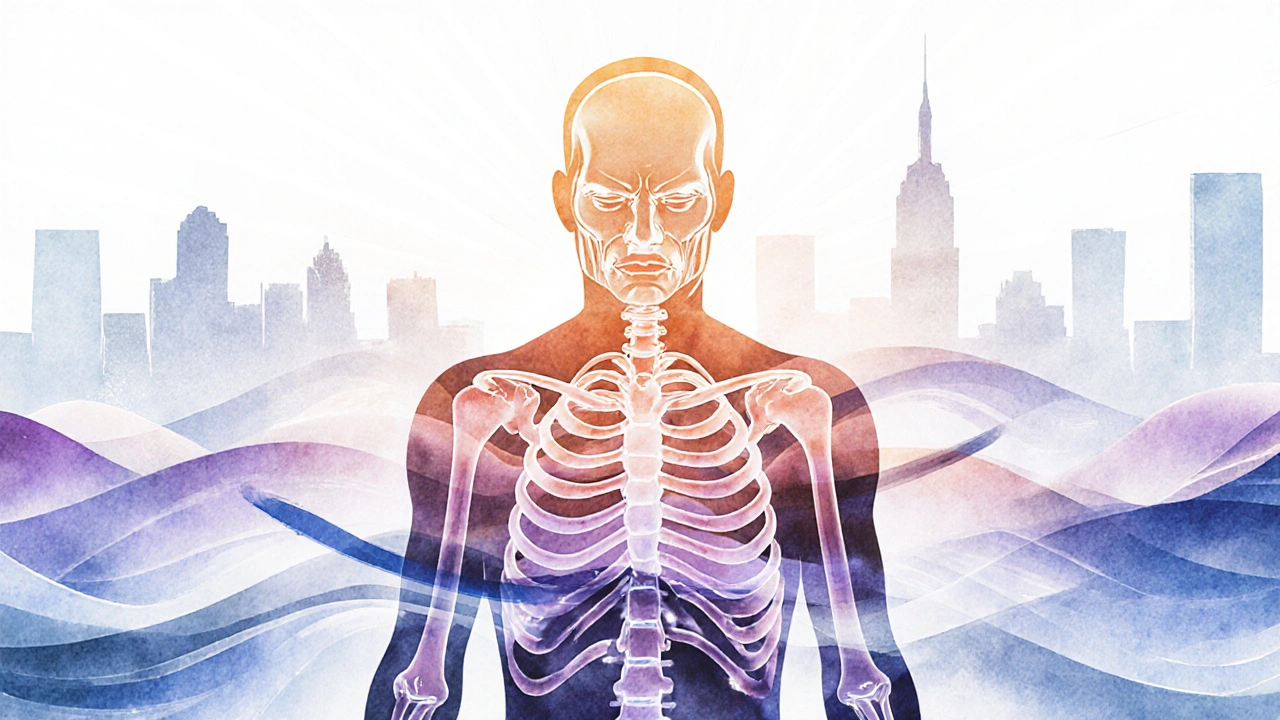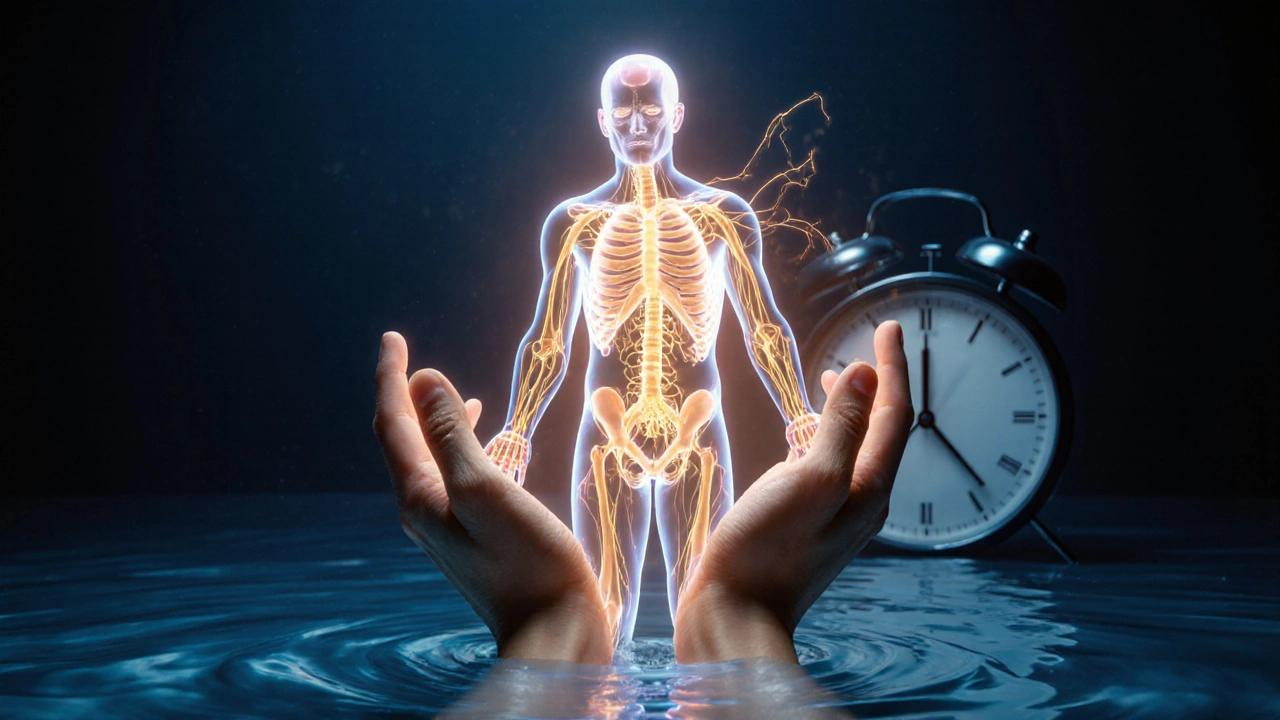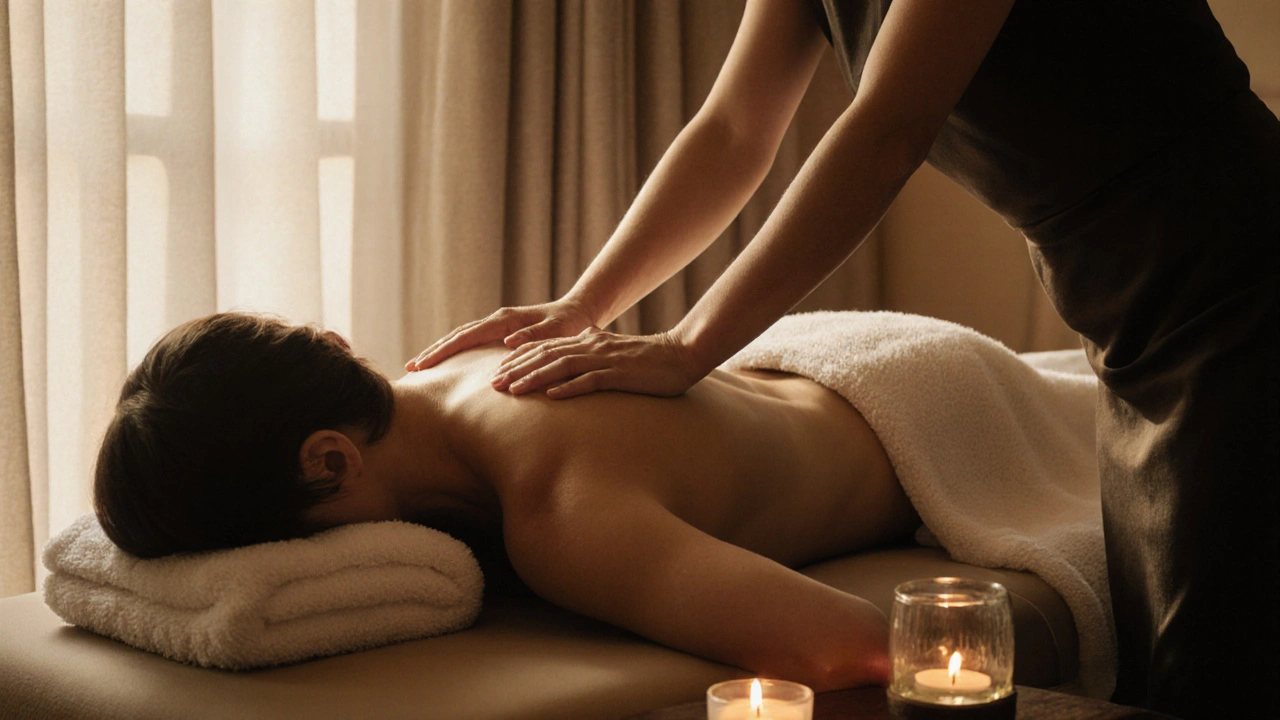Unravel the Mysteries of Full Body Massage and Its Benefits

You’ve probably seen it advertised: full body massage. Maybe you’ve even tried it once-just to see what all the fuss was about. But did you walk away feeling truly reset? Or did you just leave with a slightly looser neck and a vague sense of "that was nice"? If it’s the latter, you’re not alone. Most people treat full body massage like a luxury treat, not a tool for real, lasting recovery. But here’s the truth: when done right, a full body massage doesn’t just relax you-it rewires how your body handles stress, pain, and fatigue.
What Exactly Is a Full Body Massage?
A full body massage isn’t just "more of the same." It’s a structured, intentional session that covers your back, shoulders, arms, legs, feet, hands, neck, and sometimes even your head and scalp. It’s not about hitting every muscle with the same pressure. It’s about reading your body-where it’s tight, where it’s numb, where it’s holding onto years of stress. A skilled therapist doesn’t just move hands over skin. They sense tension patterns, adjust pressure, and respond to your breathing.
Think of it like tuning a guitar. You don’t just pluck all the strings at once. You listen. You adjust one at a time until the whole instrument sings. That’s what a good full body massage does for your nervous system.
Why Your Body Craves This
Let’s be real: life today is a constant low-grade emergency. Emails ping. Kids scream. Commutes drain you. Your shoulders stay clenched even when you’re sleeping. A full body massage doesn’t just scratch the surface-it hits the root. Here’s what actually changes when you let someone work on your whole body:
- Stress hormones drop: Cortisol levels can fall by up to 50% after just one session, according to research from the University of Miami’s Touch Research Institute. That’s not a placebo. That’s biology.
- Muscle tension melts: Chronic tightness in your traps, lower back, or hips? It’s not just "bad posture." It’s your nervous system stuck in fight-or-flight mode. Massage tells your body it’s safe to relax.
- Blood flow improves: Better circulation means more oxygen and nutrients reach your muscles, helping them recover faster-even if you’re not an athlete.
- Pain signals slow down: Massage stimulates the release of endorphins, your body’s natural painkillers. It also interrupts the pain-spasm-pain cycle that keeps you stuck in discomfort.
- Sleep gets deeper: If you’ve ever woken up after a massage feeling like you slept for eight hours even though you only got five-you know this one. The parasympathetic nervous system kicks in, and your body finally hits reset.
One client in Amsterdam, a nurse working 12-hour shifts, told me she started getting weekly full body massages after her third straight month of insomnia. Within three weeks, she stopped needing caffeine after lunch. Not because she was magically healed-but because her body finally stopped running on emergency mode.
Types of Full Body Massage You’ll Find in Amsterdam
Not all full body massages are created equal. In Amsterdam, you’ve got options-and knowing the difference helps you pick what your body actually needs.
- Swedish Massage: The classic. Long, flowing strokes, light to medium pressure. Perfect if you’re new to massage or just want to unwind after a long week. Think of it as a warm hug for your muscles.
- Deep Tissue Massage: Targets deeper layers of muscle and connective tissue. If you’ve got knots in your shoulders that feel like rocks, or lower back pain that won’t quit, this is your go-to. It’s not about pain-it’s about precision.
- Hot Stone Massage: Smooth, heated stones are placed along your spine and moved over tense areas. The heat relaxes muscles so deeply that the therapist can work with less pressure. Great for chronic stiffness or cold sensitivity.
- Thai Massage: You stay fully clothed. The therapist uses their hands, knees, and feet to guide you through stretches. It’s like yoga, but someone else is doing the work. Excellent if you’re stiff from sitting all day.
- Lymphatic Drainage Massage: Gentle, rhythmic movements that help your body flush out toxins and reduce swelling. Ideal after travel, surgery, or if you’re feeling puffy or sluggish.
Most reputable studios in Amsterdam offer custom sessions-you tell them what you need, and they adjust the technique. No one-size-fits-all here.
What Happens During Your First Session
Walking into a massage studio for the first time can feel awkward. What do you wear? Do you talk? What if you fall asleep? Here’s what you can actually expect:
- You’ll fill out a short intake form-medical history, areas of pain, preferences. This isn’t bureaucracy. It’s safety.
- The therapist will ask a few quick questions: "Where do you carry stress?" "Do you prefer light or firm pressure?" "Any injuries?" Be honest. This isn’t a judgment zone.
- You’ll be shown to a warm, quiet room with soft lighting. Music is optional. Some people like silence. Others like nature sounds. Tell them what works.
- You’ll undress to your comfort level. Most people keep their underwear on. You’ll be covered with a towel the whole time-only the part being worked on is exposed.
- The session lasts 60 to 90 minutes. You’ll lie face down first, then flip over. The therapist will leave the room while you get settled.
- You’ll be gently reminded to breathe. If you’re holding your breath, your muscles stay tight. Breathing is part of the healing.
- At the end, you’ll be given water and a few minutes to sit quietly. Don’t rush out. Your nervous system is still settling.
And yes-you might fall asleep. That’s not a failure. That’s your body saying, "Thank you. I needed that."

How Much Does It Cost in Amsterdam?
Prices vary, but here’s the real breakdown:
| Session Length | Price Range (EUR) | Best For |
|---|---|---|
| 60 minutes | €65-€90 | First-timers, maintenance, stress relief |
| 90 minutes | €90-€130 | Chronic tension, deep recovery, athletes |
| 120 minutes | €120-€180 | Full reset, post-travel, post-surgery |
Higher prices usually mean more experience, quieter spaces, or premium oils. But don’t assume expensive = better. Some of the most effective sessions I’ve seen were at small studios in De Pijp for €70. What matters is the therapist’s attention, not the price tag.
Many places offer package deals: buy five sessions, get one free. That’s a smart way to make it sustainable. One session helps. Regular sessions heal.
How to Find a Good Therapist in Amsterdam
Not every massage therapist is trained the same. Here’s how to spot a good one:
- Look for certifications from recognized schools: AMT (Association of Massage Therapists) or IBMT (International Bodywork and Massage Therapy).
- Read reviews that mention specifics: "They noticed my shoulder was tight from typing" > "Great massage!"
- Ask if they customize sessions. If they say "We do the same for everyone," walk away.
- Visit the studio. Is it clean? Quiet? Do they offer water afterward? These details matter.
- Trust your gut. If you feel rushed or judged, it’s not the right fit.
Some popular spots in Amsterdam with strong reputations: De Massagekamer in Jordaan, Body & Soul near Vondelpark, and Amsterdam Wellness Studio in Oud-Zuid. But don’t just go by name-check recent reviews and ask for a consultation before booking.
Full Body Massage vs. Deep Tissue Massage
People often confuse these. Here’s the difference:
| Feature | Full Body Massage | Deep Tissue Massage |
|---|---|---|
| Goal | Relaxation, circulation, overall stress relief | Release chronic muscle tension, break up adhesions |
| Pressure | Light to medium | Medium to firm |
| Technique | Long strokes, kneading, circular movements | Slow, focused pressure, cross-fiber friction |
| Areas Covered | Entire body: back, legs, arms, neck, feet, hands | Targeted areas (e.g., lower back, shoulders, hips) |
| Best For | Stress, fatigue, sleep issues, general wellness | Chronic pain, injury recovery, athletes, desk workers |
Many people start with full body to reset, then add deep tissue monthly for problem areas. You don’t have to choose one forever.

What to Avoid
Massage isn’t risk-free. Here’s what to watch out for:
- Don’t book if you have an open wound, fever, or recent injury without clearance from your doctor.
- Don’t let a therapist ignore your pain signals. "It hurts but feels good" is a red flag. Real relief shouldn’t feel like torture.
- Don’t skip hydration. Your body flushes out metabolic waste during massage. Drink water afterward.
- Don’t expect miracles after one session. Real change takes consistency.
Frequently Asked Questions
Is full body massage worth it if I’m not in pain?
Absolutely. Most people wait until they’re in pain to try massage. But prevention is way more effective. Regular sessions keep your muscles loose, your nervous system calm, and your sleep steady. Think of it like brushing your teeth-you don’t wait until you have a cavity.
How often should I get a full body massage?
For stress relief or general wellness: once a month. If you’re dealing with chronic tension, sitting all day, or recovering from injury: every two weeks. Athletes or high-stress professionals often go weekly. The key is consistency, not intensity.
Can I get a full body massage if I’m pregnant?
Yes-but only with a therapist trained in prenatal massage. Regular full body massage can be unsafe in early pregnancy or if you have complications. Look for specialists who use side-lying positions and avoid pressure on the abdomen. Many studios in Amsterdam offer dedicated prenatal sessions.
Do I need to undress completely?
No. You undress to your comfort level. Most people keep their underwear on. You’ll be covered with a towel the whole time. The therapist only uncovers the area they’re working on. Privacy and comfort are non-negotiable.
What if I’m ticklish?
Tell them before the session starts. Good therapists adjust their technique-using slower, firmer pressure or avoiding certain spots. You’re not being rude. You’re helping them do their job better.
Can I get a full body massage after a workout?
Yes, but wait at least 2-3 hours. Immediately after intense exercise, your muscles are inflamed. A massage too soon can make soreness worse. Wait until the initial burn fades, then go for a light to medium session to speed up recovery.
Ready to Reset?
You don’t need a spa weekend or a luxury resort to feel like yourself again. Just one hour of focused touch-where someone pays attention to your body without asking you to fix anything-can shift your whole week. Start small. Book a 60-minute session. See how you feel after. Then decide if you want to go deeper.
Your body has been holding on longer than you realize. It’s time to let go.



ANDRES BELLO GARCIA
November 11, 2025 AT 06:23I used to think massage was just a fancy spa thing. Then I started getting them after my back flared up from sitting all day. One 60-minute session and I could actually bend over again. No magic, just pressure where it needed to be.
Ashley Williams
November 12, 2025 AT 05:46OMG YES. I’m a nurse too and I swear by my weekly massage. I used to fall asleep on the couch at 8pm. Now I’m still awake at 11pm reading books. My body finally stopped screaming for help. Also, the Thai massage place near me? They use coconut oil and it smells like heaven. 🌿
Carolyn Kay
November 13, 2025 AT 05:42Let’s be real-the whole ‘cortisol drops by 50%’ claim is wildly overstated. The University of Miami study they cited? That was a 2005 trial with 26 participants. And they didn’t control for placebo effect or sleep quality. Also, ‘rewires your nervous system’? That’s not even a real physiological term. This article reads like a marketing brochure disguised as science. And why is every massage place in Amsterdam suddenly a ‘wellness sanctuary’? It’s just a person rubbing your back. Stop overcomplicating it.
Olga Jonkisz
November 13, 2025 AT 23:45Ugh. I went to this ‘luxury’ place in Jordaan and the therapist was literally asleep halfway through. I paid 130 euros for a nap? I’ve had better sessions in Bangkok with a guy who spoke zero English but had hands like magic. Also, Swedish massage? Please. That’s for people who think ‘relaxation’ means lighting a candle and whispering ‘om’. I want deep tissue with hot stones and a side of existential crisis. That’s real healing.
somya katiyar
November 14, 2025 AT 02:15This is so helpful! I’ve been thinking of trying a massage but was overwhelmed by all the types. I didn’t know lymphatic drainage was a thing-my legs get so puffy after long flights. I’m from India and we don’t really have this culture here, but I’m curious. Would you recommend starting with Swedish if I’m nervous?
Timi Shodeyi
November 15, 2025 AT 15:07Grammar check: ‘you’re not alone’ should be ‘you are not alone’-but I get what you mean. Also, ‘fight-or-flight mode’ needs a hyphen. Anyway, this is solid. I’ve been sitting at a desk for 10 years and my hips scream every morning. I booked a 90-minute deep tissue last week. Felt like I’d been hit by a truck. Woke up the next day like a new person. Worth every euro.
F. Erich McElroy
November 16, 2025 AT 12:30Anyone else notice how every article about massage these days sounds like it was written by a yoga instructor who just got off a 10-day silent retreat? ‘Your body has been holding on longer than you realize’-what is this, a self-help podcast? It’s just a massage. Not therapy. Not enlightenment. Not a reset button for your soul. Stop selling snake oil with poetic language.
Brittany Parfait
November 16, 2025 AT 22:13I got my first massage after my dad passed. I didn’t know I was holding my breath until the therapist said ‘breathe’… and I started crying. Didn’t even know why. That hour? Changed everything. No fancy words needed. Just hands. Quiet room. A little warmth. That’s all.
Renee Bach
November 18, 2025 AT 00:48Just got back from my first full body massage today 😌💖 The hot stones? Pure bliss. I cried a little. Not sad tears-happy ones. The therapist asked if I wanted music and I said no, so it was just my breathing and the rain outside. Felt like I was floating. Also, I drank 3 glasses of water after. My body is so happy. 🙏💧
Natali Kilk
November 18, 2025 AT 14:13You think you’re healing? Nah. You’re just temporarily silencing the noise your soul has been screaming at you for years. Massage doesn’t fix trauma-it just gives your nervous system a nap. And let’s be honest, if you need a €180 session to feel human again, maybe you should ask why you’re living like a stressed-out robot in the first place. The real fix? Disconnect. Breathe. Stop scrolling. Stop hustling. Stop outsourcing your peace to a stranger with oil-stained hands. But hey-if the hot stones make you feel better? Go for it. Just don’t confuse temporary relief with transformation.